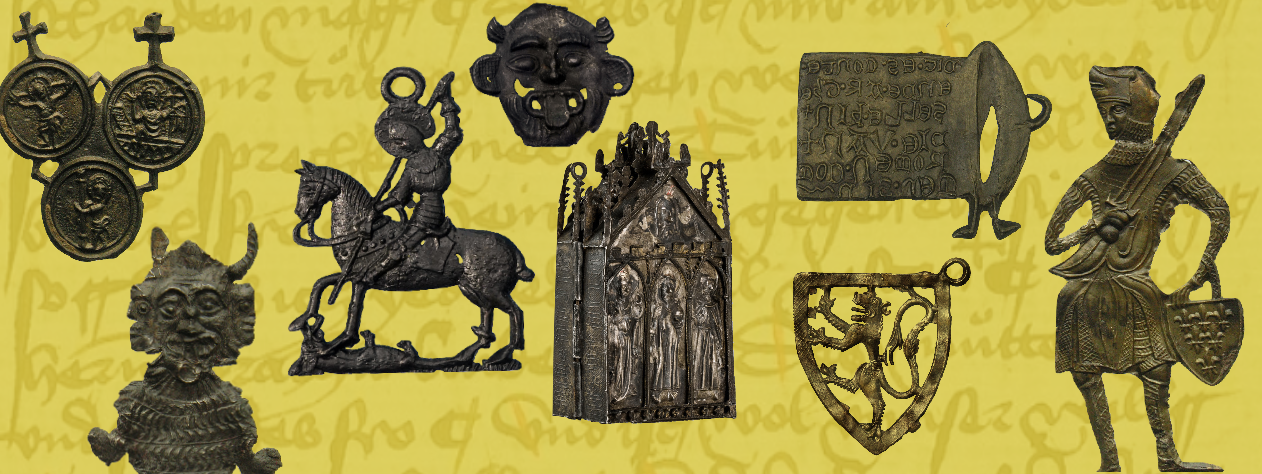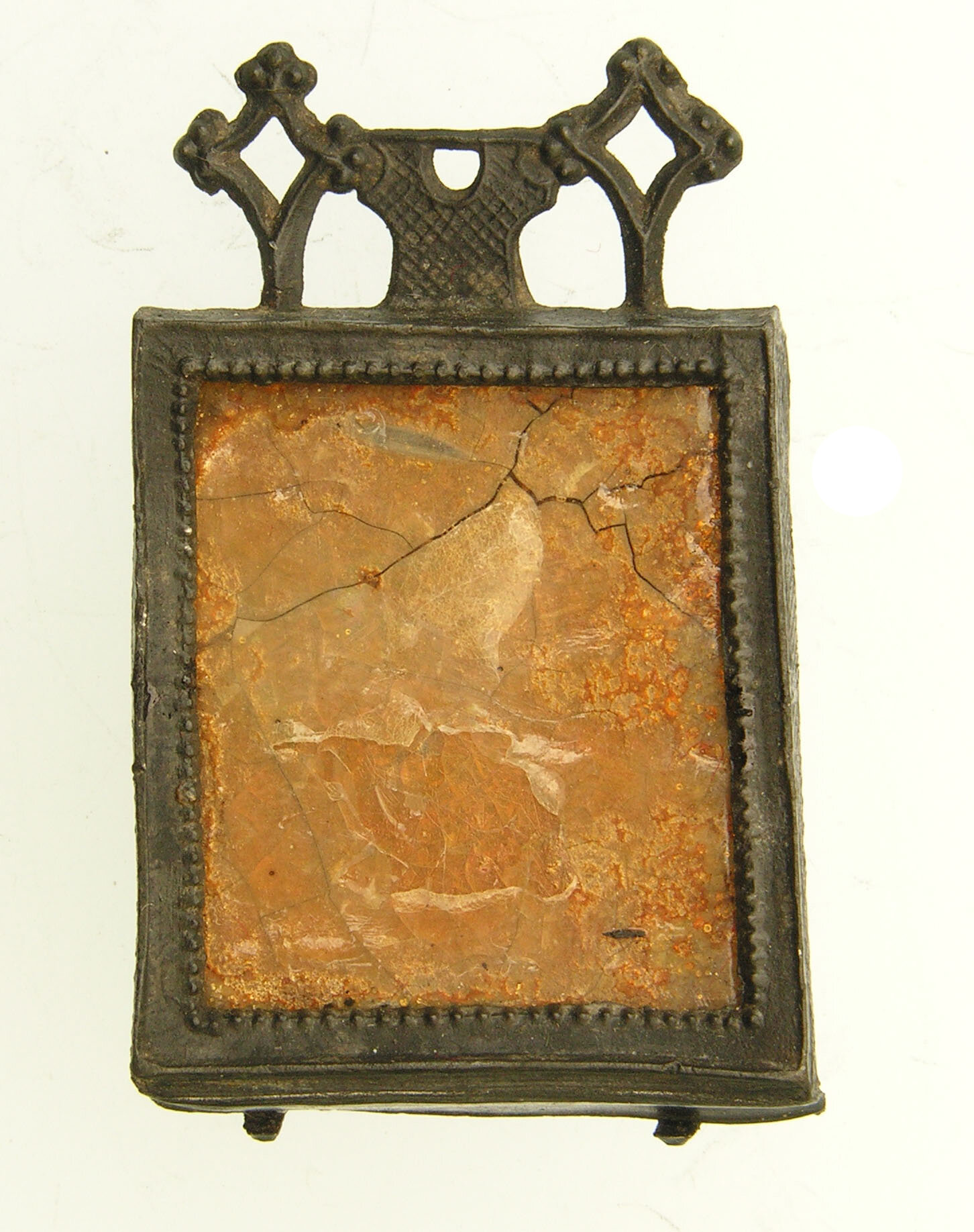Interview with Dr. Carolin Rinn: Pilgrim Badges from Aachen and Canterbury
Aachen Cathedral and Canterbury Cathedral were well-known medieval pilgrimage sites. Aachen Cathedral was built under the orders of Charlemagne in the late eighth century and he was buried there in 814. In addition to Charlemagne’s tomb, this site famously houses four holy relics: the tunic Mary wore when giving birth to Christ, Christ's swaddling clothes, the beheading cloth of John the Baptist, and Christ’s loincloth. Canterbury Cathedral is famous for being the site of the martyrdom of archbishop Thomas Becket in 1170, whose shrine became one of the most important pilgrimage sites in medieval Europe.
To learn more about the medieval badges from these famous sites, Ann Marie Rasmussen met virtually with Dr. Carolin Rinn to discuss her dissertation, “Between Memory and Mediation of Salvation: Visuality and Mediality of the Medieval Pilgrim Badges from Aachen and Canterbury.” Carolin shared her experience studying medieval badges as an art historian and the findings and implications of her research.
AMR: Your dissertation explores the visuality and mediality of pilgrim badges from Aachen and Canterbury. Could you tell us how these worked at the sites?
CR: The visuality – the iconography of the saints, the legends, the cathedral, and the design of these pilgrim badges – in Aachen and Canterbury is different. [In Aachen] you have Mary as the patron of the cathedral. You also have Charlemagne and some very important relics that are housed there. In Canterbury, visuality is centred around Thomas Becket and his spectacular martyrdom. Becket’s likeness to the suffering and sacrifice of Christ was a very big topic. The mediality of the badges from the two sites is also different. In Canterbury, there were both badges and ampullas. The ampullas contained the blood of Thomas Becket mixed with water, so they said. [This so-called “Canterbury water”] could heal diseases and cause miracles, which we know from the famous miracle records from that time. Buying an ampulla with this special substance was one reason pilgrims went to Canterbury. There are relationships between this substance and the images [on the ampullas], the front and the back of the badges, the frame, and so on. In Aachen, there was no substance. There are relics from Christ, John, and Mary at the site, but nothing pilgrims could take with them. Only the badges.
AMR: Could you tell us about the mirrors on some of the Aachen badges?
Pewter badge, square frame intended to hold a mirror surmounted by tunic on rod supported on either side by posts topped with deorated diamond, eyelets, Aachen, Germany, 1475-1524, found in Nieuwlande, the Netherlands, 45 x 29 mm. The Van Beuningen Family Collection, inv. 0674 (Kunera 00430). Photograph courtesy of The Van Beuningen Family Collection.
CR: Oh, yes. Special badges from Aachen had these little mirrors built in. When the relics were shown to the pilgrims from the church tower, which has happened every seventh year, basically from the Middle Ages until now, we know that the pilgrims were massed far below. We know that mirrors were raised up to probably “see” the relic and its power, which was collected in the mirror. Many Aachen pilgrim badges bought by pilgrims included both a mirror and an image of the tunic Mary wore when giving birth to Christ, which was the top relic.
Another element commonly found on the Aachen badges that I found very interesting is the face of Christ. It's very big and very dominant. So I wondered, what's that about? You could say it’s the Vera Icon, but the Vera Icon was a relic in Rome, and therefore not specific to Aachen. There were relics of Christ in Aachen, but none related to the Vera Icon. At first, this made no sense to me, but then, what came into my mind was that this face of Christ – which is basically staring at you – might be a preview of seeing God at the end of time. There are these famous words in the Bible by the Apostle Paul who says, ‘You can see God only like in a dark mirror, but not clearly until the last judgement.’ This is a new finding from my dissertation.
AMR: But then you shall see face to face. [see 1 Corinthians 13.12]
CR: Yes, face to face. These words were very important for thinking about how devotion and prayer worked in the Middle Ages, especially during the fifteenth century: you never get to the point you want to get to, but you always have to try. I don’t think that every pilgrim would have thought about this impact, but well-educated pilgrims must have known these discussions and theories. This shows that pilgrim badges could also be used as devotional objects and as objects that led pilgrims to their way to salvation even after the pilgrimage.
AMR: It is really interesting that you thought about this adult face of Christ. By the fifteenth century it’s on small objects everywhere. It’s obvious they’re not from Rome, but you see this face again and again. That's really interesting. There was no face relic of any kind at Aachen.
CR: The interesting thing is that the badge also shows the theme of salvation: you have the tunic, which signifies Christ's birth in the beginning, and then you have this face of God in the end. I think the example of the face of Christ and the badge from Aachen shows that there's so much more to learn. It’s worthwhile to integrate badges into art historian research. They were important visual objects, and sometimes they are as tricky as big paintings to analyze.
AMR: Of all the badges you've seen so far, which one is your favorite and why?
CR: My favorite is still the ampulla from Canterbury with Thomas Becket, which I saw at the British Museum. It's just so beautiful. On the front side, there’s Thomas Becket, and on the right and the left sides, there are soldiers with their swords. On the back, you see the murder within a seal-shaped frame.
AMR: Their swords are raised. It's like the minute before the swords fall, right?
Front of pewter ampulla, three knights assassinate Saint Thomas Becket, 1170-1200, England, object reference: 1921,0216.62. Photograph courtesy of © The Trustees of the British Museum. Shared under a CC BY-NC-SA 4.0 licence.
Back of pewter ampulla, pointed oval panel with the martyrdom, inscribed + OPTIM EGROR MEDIC FIT TOMA BONOR [Thomas is the best doctor for the worthy sick]. Photograph courtesy of © The Trustees of the British Museum. Shared under a CC BY-NC-SA 4.0 licence.
CR: Yes! It's just so beautiful. I think it also works as a devotional object because of image on the back, which was worn near the heart. Having a badge near the heart of the pilgrim plays with this idea that you could impress good images into your heart with prayers during devotions.
AMR: There’s a very famous piece from Amsterdam, a homemade altar that has had two pilgrim badges nailed onto it. It’s clear in this case that the badges have been repurposed into a devotional object. But in other cases, it's not possible to prove it, but it makes sense.
CR: Yes, it's not possible to prove it, but I think as an art historian, if you're dealing with medieval art, you can’t prove many things, but you can show they could be possible. In this case, in that region around Canterbury at that time, we know that there were these ideas of impressing your soul with good images and seeing Thomas Becket as a good role model. Not everybody knew this, probably. The monks of Canterbury did at least. And I think it's possible that there were viewers who had these ideas in the back of their mind.
AMR: Oh, absolutely. By the fifteenth century people are beginning to argue about symbols and signs and their efficacy. Badges are made to work within these complex representational systems. The more you bring to them, the more they can say to you – just as you say, they can work on different levels.
CR: I think the idea of pilgrim badges as cheap mass products has led some scholars to think badges are not complex. Not every badge has these complexities, but some do. This is important because pilgrim badges were a medium for everybody. On every level of thinking or living in the Middle Ages, low or high, you can gain something from the pilgrim badges. I think that's fascinating.
Carolin Rinn studied art history, classical archaeology, and philosophy at the University of Giessen (Justus-Liebig-Universität Gießen). After an internship at the British Museum, Carolin returned to the University of Giessen to complete a PhD in Medieval Studies. Under the supervision of Markus Späth and Silke Tammen, she wrote a dissertation entitled, “Zwischen Erinnerung und Heilsvermittlung: Visualität und Medialität der mittelalterlichen Pilgerzeichen aus Aachen und Canterbury.” She presently works with the archeological excavation company SPAU, where she offers her historical expertise to guide visitors through various sites, which she views as a pilgrimage of sorts. She continues her research with medieval badges through her work with the Pilgerzeichendatenbank, an online database of pilgrim badges.
Edited by Hannah Gardiner and Dr. Ann Marie Rasmussen.
The interview took place on July 19, 2021.



![Back of pewter ampulla, pointed oval panel with the martyrdom, inscribed + OPTIM EGROR MEDIC FIT TOMA BONOR [Thomas is the best doctor for the worthy sick]. Photograph courtesy of © The Trustees of the British Museum. Shared under a CC BY-NC-SA 4.0 licence.](https://images.squarespace-cdn.com/content/v1/5b916f765b409bcdde473c07/1630954533747-RNN7NXL854TR6XE4HMVT/Becket+back.jpg)




![Pewter badge, Job covered in boils and sitting on the dunghill offering musicians around him a coin with inscription S. JOB TOT WE[SEMALE] GOD GAF GOD NAM, eyes, Wezemaal, Belgium, 1450-1499, found in Nieuwlande, the Netherlands, 72 x 43 mm. Langbroek, the Netherlands, Family Van Beuningen, inv. 0951 (Kunera 00235).](https://images.squarespace-cdn.com/content/v1/5b916f765b409bcdde473c07/1624285595224-ENHHO4760ASHS8YX12WF/Screen+Shot+2021-06-21+at+10.24.47+AM.png)

![DSC_1984[1].JPG](https://images.squarespace-cdn.com/content/v1/5b916f765b409bcdde473c07/1621205228794-Q1Y2NT12VXZ2UTH8IQ1H/DSC_1984%5B1%5D.JPG)













